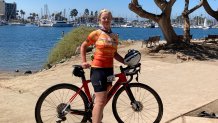Magdalena Remillard trains for triathlons pretty much year around. She bikes 70 miles, runs 7 or more miles and takes master swim classes every week.
On July 24, 2022, the 63-year-old University City resident finished third in her age division in the Solana Beach Triathlon.

But just weeks before, Magdalena was in bed after testing positive for COVID-19. Her husband Tom did as well. They were vaccinated and boosted, but have underlying health conditions. As a result, both of them got a prescription for Paxlovid from their doctor.
Get San Diego local news, weather forecasts, sports and lifestyle stories to your inbox. Sign up for NBC San Diego newsletters.
“I tested negative, was OK for a few days, and then on Sunday got really sick again and then tested positive," she said.
Then the Remillards got sick again, testing positive for a second time within a few days. They both got rebound COVID after taking Paxlovid.
Magdalena's doctor didn’t warn her about the possibility of a rebound, but, she already knew about it – because she had a friend who rebounded after taking the medication.

“I think everyone needs to make their own choices based on their own health and health history,” Magdalena said.
Local
More than 3 million courses of Paxlovid have been administered in the United States since December, according to the Department of Health and Human Services. The Food and Drug Administration approved Paxlovid for emergency use after it was proven to reduce the risk of hospitalization or death in high-risk adults by 89%.
Although the treatment has been effective for many, some have reported rebound cases of COVID-19.
That’s when someone experiences symptoms – or tests positive again – after finishing the treatment.
Last week, the White House’s COVID response coordinator said rebound rates are around 5%.
Dr. William Tseng is the assistant area medical director for Kaiser Permanente in San Diego. “It’s a small percentage, but it can happen and we do see it happen. But again, this is coming from data from May of this year.”
Dr. Tseng says those who experience rebound COVID are still contagious.
“If you get paxloivd rebound you need to start the isolation period again, so you need to do another five more days from when you test positive,” he said, adding that patients should also continue to wear a mask for 10 days after a rebound case.
Remillard is relieved she and her husband recovered from COVID-19, but says looking back, "I think in retrospect, I am not sure I would have taken it. Maybe I would have just gotten over and been done but I don’t know.”
Researchers from the UC San Diego School of Medicine found that rebound cases might be caused by insufficient exposure to the drug, meaning higher dosages or longer treatment durations could be necessary.
A June CDC study found that less than 1% of people taking Paxlovid were admitted to the hospital for COVID in the 5 to 15 days after they stopped the treatment.



